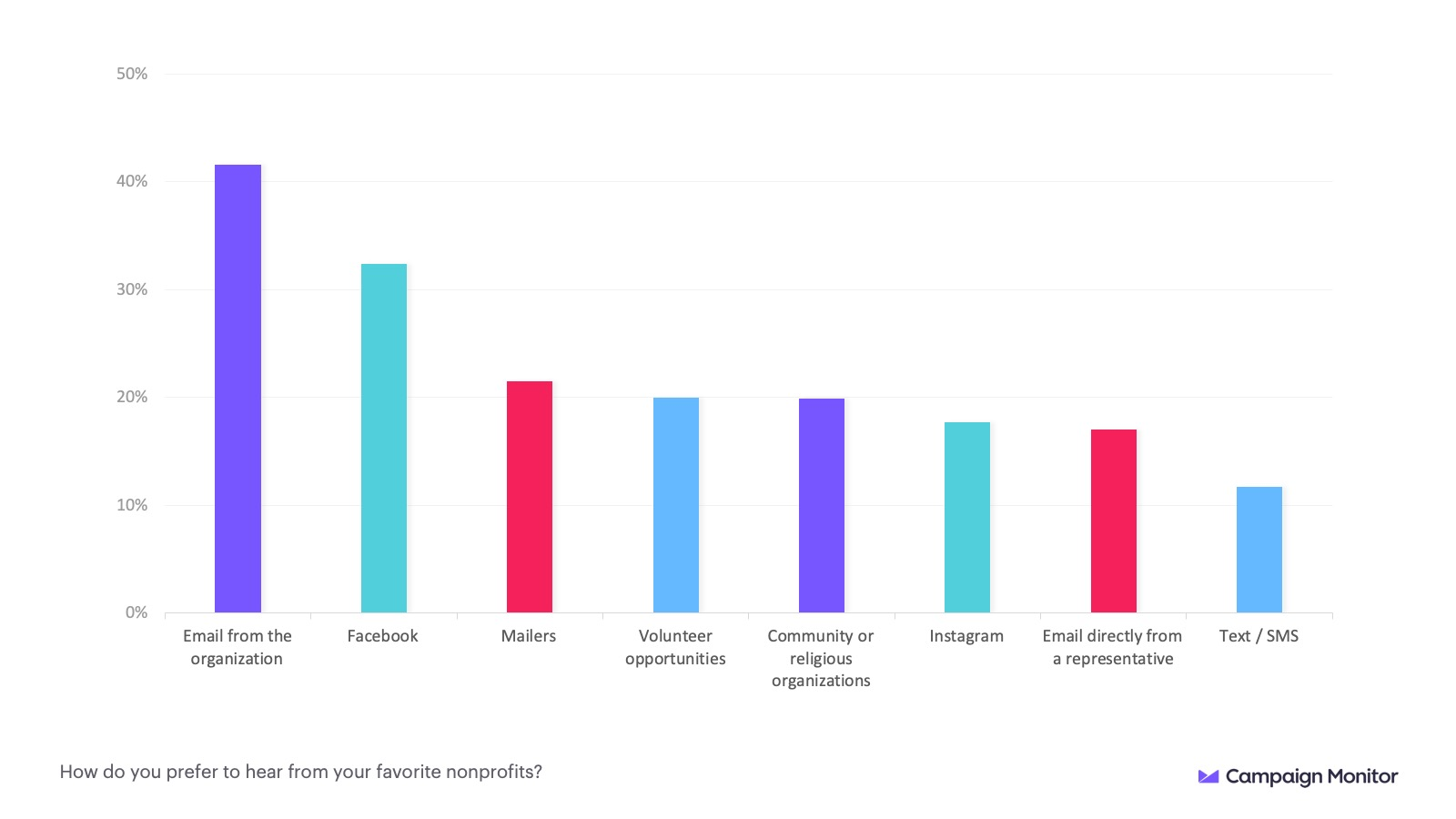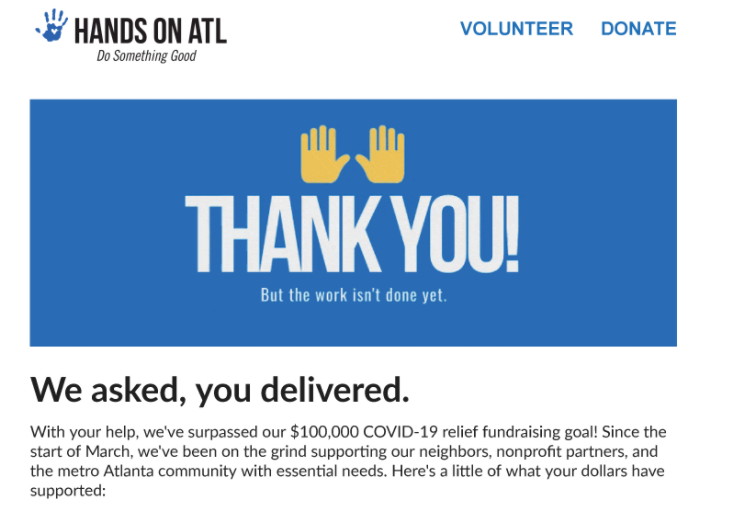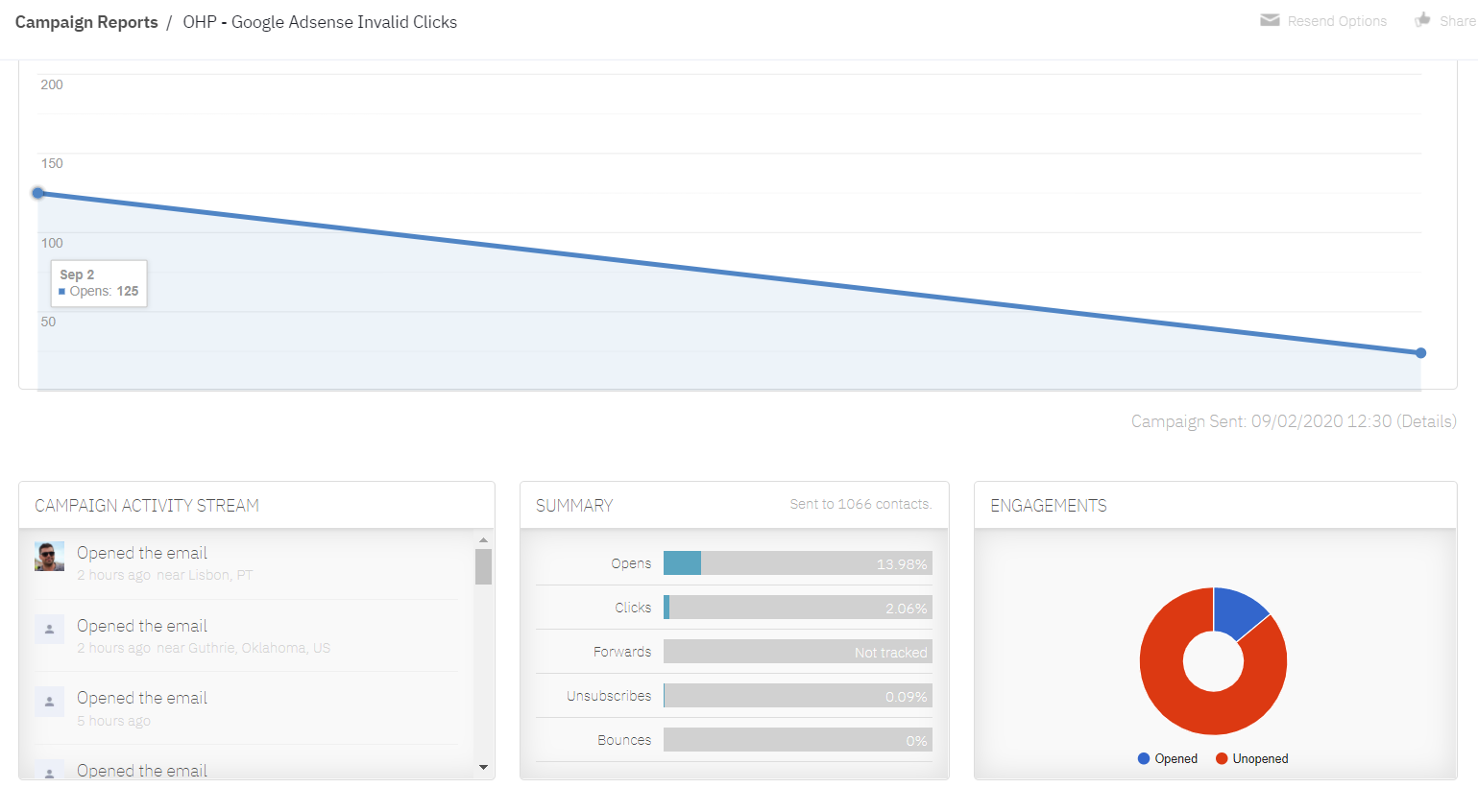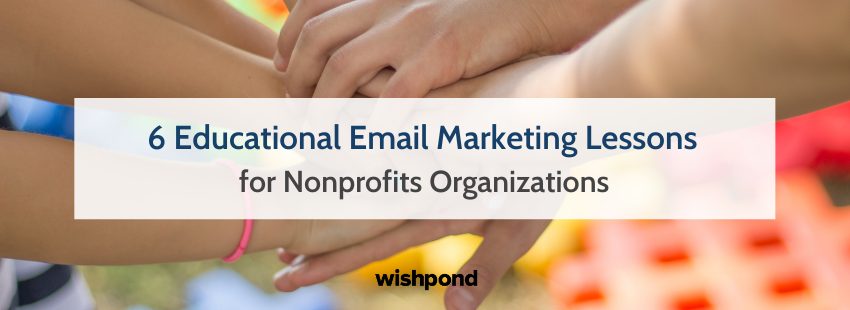Email marketing is vital for businesses that want to connect with their audiences in an effective and cost-efficient way.
With email marketing, brands can produce a very strong ROI if they leverage this powerful marketing tool correctly – and the same goes for nonprofits.
Even though padding your bottom line isn’t the goal, email marketing will help you get people involved and spread the word about your organization’s objectives. It’s also a great tool to keep both donors and volunteers engaged.
Nonprofit marketing can be daunting.
Finding donors and asking for donations is a process that involves a lot of moving parts, and donors receive tons of requests, which means you need a system that allows you to stand out and connect with them in a more personal and authentic way.
Although there are many marketing methods you can use, email marketing is one of the best ways to help you cut through the noise and convince your prospects to take massive action for nonprofit.
According to a recent study by Campaign Monitor, 42% of donors prefer to hear from non-profits through email. In fact, 21% of the respondents reported that emails from nonprofit organizations inspire them to donate.

Read on to find out everything you need to know about email marketing for nonprofits in our beginner’s guide so you can supercharge your donor base.
1. All Website Traffic is an Opportunity
Any of the individuals that you reach online are potential subscribers for your nonprofit’s email list. But, it’s important to ensure that you give them the opportunity to join your list.
You can do this in a variety of ways. For instance, you can embed lead forms on your website and then use various tactics to get prospective donors to opt into your email marketing list.
This is something that is crucial for all nonprofit organizations because, with email marketing, you own the list of donors, unlike when you connect and interact with your audience on Instagram, Twitter, or Facebook.
If you lose that social media account, the audience goes with it. But, no matter what happens to those social platforms, you will always be able to drive donations using email marketing.
2. Always Have a “Hook”
When you are trying to capture leads, it’s important to give them a compelling reason to join your list. This “hook” is called a “lead magnet” and it can be anything that your audience will find valuable and useful.
You can use a PDF download, guide, mini course, or case study as your lead magnet.
It’s vital to choose something that will be extremely relevant to your target audience. You can also create different lead magnets in order to give yourself the best chance of capturing as many emails as possible.
As an example, I’ve personally created a free course for my own audience on my website and use that as a lead magnet.

When people opt-in to get my free course, I then put them into an email campaign that automatically emails them every day for 7 total days. From there, the free course pushes them to purchase a course.
I’ve found that courses, especially those that are given away for free and are relatively short (under 1 hour) with defined outcomes, can be an amazing lead magnet. If you want to go down this route, I suggest you check out this guide to help you choose the right platform for your nonprofit.
This is vital because your email list size directly affects your organization’s average donation amount.
Once you have your email lead capture form and lead magnet ready, you can use both offline and online methods to help you grow your email list.
Off-line methods are great for getting email addresses from attendees at your events. But, online techniques are still the most effective when it comes to gathering contact information en masse.
Don’t forget to check out our guide on Social Media for Non-Profits
3. Understanding Email Types
Once you’ve got subscribers on your list, you must then begin sending them emails. The type of email you send will depend on what it is that you want your subscribers to do.
- For instance, is there an issue that you would like them to learn more about?
- Are you inviting them to attend an event?
- Or maybe you are hoping for petition signatures or a donation?
You could even send them an email just to keep your donors in the loop about what’s happening in your organization.
Here’s a quick look at three of the most important types of emails to send:
Drip Email
A drip email campaign is one that involves sending out a set of marketing emails automatically on a schedule.
Also known as drip marketing, lifecycle marketing, automated email campaigns, and marketing automation, drip emails are powerful because they allow you to connect with and engage with your audience on autopilot.
This means you can get a lot more out of your email marketing with less effort by using drip campaigns.
You can use drip email campaigns to delight your donors and volunteers and keep them engaged, as well as for advocacy and calls to action. Here is a good example from Plan International.

See how they used a simple, modern email design for their drip campaign. This is effective for capturing the attention of your audience and getting people to act on the issues you care about.
An effective drip campaign will help you to achieve consistent growth for your email list and automate demanding, time-consuming, and delicate manual tasks that otherwise might incur mistakes.
Broadcast Email
Email broadcasts are individual emails that you send to groups of subscribers on your email list. A broadcast email is most useful when you need a way to send a single email, such as an announcement or update, to the donors on your list.
These types of emails are also called mass or bulk emails.
With mass email software, you can schedule an email to be sent at a specific time but it means that all the subscribers on your email are going to receive that email at the same time, regardless of where they are in the world.
Broadcast emails are perfect for updating, educating, and nurturing your subscribers and transforming them into donors. One way to do this is by sending newsletters on a regular basis.
Here’s a great example of a newsletter from a well-known nonprofit, WWF.

Use broadcast emails to drive conversions for your flash sales, promotions, and to strengthen your relationships with your donors and volunteers through newsletters and other types of emails.
Transaction Email
A transactional email is one that is sent to one recipient, typically related to a commercial transaction or some other account activity.
Each interaction you have with one of your donors or prospective donors is critical.
Whether it’s the initial email of a major marketing campaign, or if it’s just a quick transactional email – like the thank you email in the example below – every message plays an important role in strengthening your brand image and building customer relationships.

Some of the most common uses for transactional emails include event notifications, requests for feedback, password reminders or resets, subscription welcome emails, responses to inquiries, and so on.
The bottom line is that a transactional email contains information that is relevant to its recipients. This is what sets a transactional email apart from other types of emails like broadcast emails.
Can Your Non-Profit use all of These Email Types?
Absolutely!
In fact, I’d encourage non-profits to use all of these email types to take full advantage of the email marketing platform they’re using. The difficulty in doing something like this is that you need to make sure that your emails aren’t overlapping.
Meaning, if you have someone in a 5-day drip email campaign sequence, you wouldn’t want to send them a few broadcast emails in the middle of it to interrupt the messaging that they’re getting. This is because drip campaigns typically have a very distinct goal at the end.
For a non-profit, that could be to get a lead to become a donor.
If you have a 5-day drip email campaign sequence that gets interrupted by a broadcast email, it may distract the email recipient from the primary goal that you have of becoming a donor.
In terms of transactional emails, I think you can send those at any time. Considering those are based on a desired action that your users take, I don’t think you need to reduce their delivery so long as they aren’t overwhelming.
4. Deliver Value Before Asking For Something
When sending out emails for your nonprofit, it’s important to give value to your subscribers before asking for anything.
You can give helpful information, educational material, or anything else that your audience will find useful. Only then can you ask for donations to your organization. But, if you focus on donations alone, you’re likely to alienate a lot of potential donors.
No one likes to be bombarded with endless donation requests, but your audience will appreciate all your emails that offer value. Such emails will allow you to build trust and make it more likely that your subscribers will give when you do ask for a donation.
Video is a great way to build trust with your audience as well. There aren’t too many nonprofits that include video in their emails, but I’ve found from experience that people really like video as it shows there are people behind the brand, not just a brand itself.
Depending on what your nonprofit is, video also might be a great way to connect them with the cause and show them what their donations are actually doing. If you can’t afford to hire a video editing company and have someone within the company willing to learn, there are plenty of editing software platforms available that can help.
Some types of emails that you can send to ensure you’re not focusing on donations alone include the following:
- Give your subscribers updates on specific projects you’re working on
- Email monthly donation reports showing transparency in how you are using funds
- Send donors thank you emails
- Share interesting case studies
- Send your donors coupons or gifts
The important thing here is to use your email marketing to build strong relationships with your prospective donors and provide them with lots of value before you ask them to contribute to your cause.
Take the time to show your new subscribers the reasons why your mission is so vital.
For instance, you can woo them by creating a welcome series with four or five emails triggered to send a couple of weeks apart. These emails can include a warm welcome from your organization’s CEO, as well as stories of impact, links to your blog and social media, and some helpful resources.
You can also showcase behind-the-scenes information that will help your prospective donors feel more connected to all the work you do.
5. Don’t be Spammy
When deciding the frequency of your emails, keep in mind that sending too many emails will be viewed as spammy and it will lead to a lot of unsubscribes.
Although the people that join your nonprofit’s email list do so because they are connected to your cause, it’s still very easy to alienate subscribers by sending too many emails.
According to an M+R Benchmarks report, most nonprofits send out about 59 emails each year. This seems like a good number to stick to if you don’t want to inundate your donors with emails.
In addition to getting the frequency right, it’s also important to ensure that people actually want to receive your nonprofit emails. You should strive to ensure that your subscribers look forward to your next email and are eager to open it to see what you have to share.
This is yet another reason to avoid asking for donations too frequently, but rather find different ways to provide interesting, useful, and valuable content for your subscribers.
Steering clear of the spam folder isn’t very hard if you simply stick to these few best practices.
Also, you must always use confirmation emails to ensure that the emails you receive are real.
6. Don’t Forget Analytics
One of the most important aspects of your email marketing campaign is the analytics. After all, it’s impossible to improve something if you can measure it.
Keeping track of the right email marketing metrics will help you to determine how successful your email marketing campaign is.
Listed below are some of the most common metrics that nonprofits should pay attention to:
- Open Rate
- Click through Rate
- Unsubscribe Rate
- Donation Rate
- List Size
- Non-Confirmed Emails
Keeping track of these and other important email metrics will help you to analyze and adapt in order to ensure the best results from your email marketing campaign.
No matter how good your existing approach is, it can always be improved upon. By focusing on the right email marketing metrics, you will continue to experience better and better results from your marketing efforts.
Here are some of the analytics that I get using my email service provider:

You can see that this page includes the open rate, clicks, forwards, unsubscribes, and bounces. It also shows who my contacts are that opened the emails and how many have been unopened.
The good news is that all email service providers have robust tools for analytics, so you can measure your performance and better inform your decisions for your future promotions.
For example, if you find that your emails have a low open rate, it could be an indication that your subscribers are not very interested in the type of content you are sending them. Or, it could be that your subject lines are not grabbing their attention.
With the right email marketing platform, you can A/B test your emails to avoid making such a mistake more than once.
Nonprofit Email Examples
In this section, we take a look at the examples of nonprofit emails and why they are effective. While it’s not clear if these brands had a digital agency helping them with these emails, the examples are still very good and give ideas of what you can aspire to create.
1. Charity: Water
This email is extremely effective because it shares a story of success. You can send similar emails showing someone who benefits from your organization as a way of providing proof of your nonprofit’s impact.

2. World Disaster Response
It can be an uphill battle trying to stand out in your donors’ inboxes. But, with a number and statistics-based email like the one in the example below, it’s easy to capture the attention of your subscribers.

3. WWF
Storytelling is a big part of a nonprofit email marketing strategy. It’s a great way to draw readers in emotionally, as shown by the example from this charity below. You can use the same tactic to mix eye-catching imagery with compelling email copy to get your donors to take action.

Conclusion
Email marketing is a great tool for both businesses and nonprofits alike. Its unique outreach capability makes it particularly suited for encouraging donations.
When you’re considering any type of email marketing for your own nonprofit remember the lessons that were covered in this post. All website traffic is an opportunity, you always need a “hook” to grow your list, there are different email types for different situations, value should always come first, you should never be spammy, and finally to lead with analytics.
If you follow these best practices, your nonprofit will have a much greater chance of success with their email marketing campaign than most competitors out there.
Which of our tips have you included in your email marketing strategy? Let us know in the comments section below!
About the Author

Ron Stefanski is a professor, youtuber, and online entrepreneur who has a passion for helping people create and grow online businesses. Visit his website to learn more: OneHourProfessor.com


